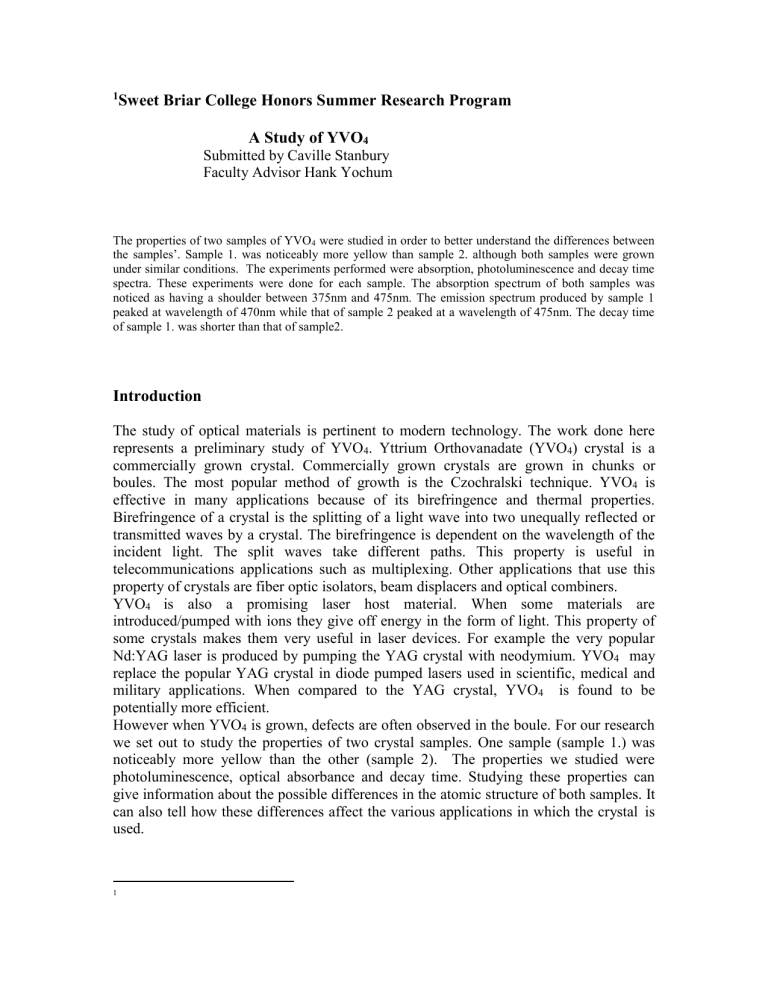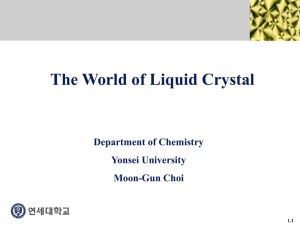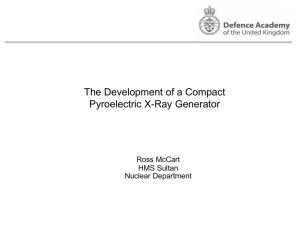A Study of YVO4

1
Sweet Briar College Honors Summer Research Program
A Study of YVO
4
Submitted by Caville Stanbury
Faculty Advisor Hank Yochum
The properties of two samples of YVO
4
were studied in order to better understand the differences between the samples’. Sample 1. was noticeably more yellow than sample 2. although both samples were grown under similar conditions. The experiments performed were absorption, photoluminescence and decay time spectra. These experiments were done for each sample. The absorption spectrum of both samples was noticed as having a shoulder between 375nm and 475nm. The emission spectrum produced by sample 1 peaked at wavelength of 470nm while that of sample 2 peaked at a wavelength of 475nm. The decay time of sample 1. was shorter than that of sample2.
Introduction
The study of optical materials is pertinent to modern technology. The work done here represents a preliminary study of YVO
4
. Yttrium Orthovanadate (YVO
4
) crystal is a commercially grown crystal. Commercially grown crystals are grown in chunks or boules. The most popular method of growth is the Czochralski technique. YVO
4
is effective in many applications because of its birefringence and thermal properties.
Birefringence of a crystal is the splitting of a light wave into two unequally reflected or transmitted waves by a crystal. The birefringence is dependent on the wavelength of the incident light. The split waves take different paths. This property is useful in telecommunications applications such as multiplexing. Other applications that use this property of crystals are fiber optic isolators, beam displacers and optical combiners.
YVO
4 is also a promising laser host material. When some materials are introduced/pumped with ions they give off energy in the form of light. This property of some crystals makes them very useful in laser devices. For example the very popular
Nd:YAG laser is produced by pumping the YAG crystal with neodymium. YVO
4
may replace the popular YAG crystal in diode pumped lasers used in scientific, medical and military applications. When compared to the YAG crystal, YVO
4
is found to be potentially more efficient.
However when YVO
4
is grown, defects are often observed in the boule. For our research we set out to study the properties of two crystal samples. One sample (sample 1.) was noticeably more yellow than the other (sample 2). The properties we studied were photoluminescence, optical absorbance and decay time. Studying these properties can give information about the possible differences in the atomic structure of both samples. It can also tell how these differences affect the various applications in which the crystal is used.
1
Experimental and Results
2
Poly Scientific Division of Northrop Grumman grew the crystals used in these experiments by the Czochralski technique. A ultra-violet visible spectrophotometer was used to obtain the absorption spectra of both samples. A graphical representation was produced of the degree of absorbance of each wavelength, which entered the crystal. The decay time for sample 1. was 34
s and for sample 2. was 43
s
1
0.9
0.8
0.7
0.6
0.5
0.4
0.3
0.2
0.1
0
350
Sample 1
Sample 2
370 390 410 430
Wavelength (nm)
450 470 490
Graph 1.
As shown in Graph 1. both samples have an absorbance shoulder between 375nm –
475nm. However, the absorbance of sample 1. at the shoulder was noticeably more than that of the sample 2. This increase in absorbance can be attributed to oxygen vacancy in the atomic structure of sample 2. Oxygen vacancy is a lack of oxygen ions in the structure of the crystal. This lack of oxygen ions could also be responsible for the more yellowed appearance of sample 1.
The samples were both excited at 337nm and their fluorescence spectra taken. The fluorescence spectrum is a graphical representation of the wavelengths produced or emitted and shows the intensity of each. This excitation wavelength was chosen because shown in Graph 1. both samples absorbed light of this wavelength significantly. Both samples emitted light of various wavelengths. As shown in Graph 2, the emission spectrum produced by sample 1 peaked at wavelength of 470nm while that of sample 2 peaked at a wavelength of 475nm. The emission of both samples was bluish in colour.
The fluorescence spectrum obtained for the sample 1. also showed a shift towards the larger wavelength. Sample 1. absorbed more of the shorter wavelengths and less of the longer wavelengths than sample 2.
2
Sample 1.
Sample2.
0.8
0.6
0.4
0.2
0
-0.2
350
-0.4
400 450 500 550 600 650 700
Wavelength (nm)
Graph 2.
The differences noted in samples’ emission spectra suggest differences in crystal impurities and/or structure. The YVO
4
has zircon tetragonal crystal structure. Our findings suggest that the structure of our defected sample has a deficiency of oxygen ions. Previous researches done on YVO4 agree with this hypothesis. While other works suggest that the emission observed from sample 1. is related to the transition of VO
3-
4 ions. We are however unable to conclusively attribute the difference in emission to oxygen vacancies.
For each sample, the decay time of specific emitted wavelengths was taken. Across each band the decay times were found to be within 3
s of each other. That is, for every wavelength of each sample the decay time was found to be similar. However, the average decay times for the samples were different. The decay time for sample 1. was 34
s and for sample 2. was 43
s.
Comparison Of Natural Log of Intensity
Decay for Coloured and Uncoloured
Sample
0
-0.5
0
-1
-1.5
-2
-2.5
-3
-3.5
20 40 60 80 100
Time (
s)
Graph 3.
Graph 3. shows a linear representation of the average decay time for both samples at their peak wavelengths from their respective fluorescence spectrum.
Sample 1.
This difference in decay times also suggests that there is a difference in the samples’ structures.
Sample 2.
Future Direction
We wish to conduct experiments over a wider range of absorption strengths at the shoulder. We intend to verify our current results by studying the photoluminescence and decay time spectra at the observed shoulders of our new samples.
References
Applied Physics Letters, Volume 80 number 7, Anti-Stokes emission in undoped YVO
4,
Ryba Romanowski et al, 2002.
Optics Letters, Volume 19, number 16, Decoloration of yttrium orthovanadate laser host crystals by annealing, Y. Nobe et al, 1994.
YVO
4
crystals – puzzles and challenges, W. Ryba Romanowski, 2003
Luminescent Materials. G. Blasse, B.C. Grabmaier, Springer- Verlag, 1994










